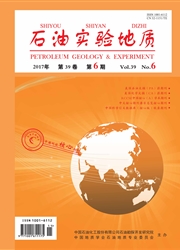

 中文摘要:
中文摘要:
利用核磁共振技术,对东濮凹陷文东沙三中深层高压低渗砂岩储层样品进行测试分析,通过可动流体百分数、可动流体孔隙度参数分析了可动流体的赋存特征及控制因素。研究结果表明,不同离心力的T2谱形态表现为4种类型,T2截止值与物性呈正相关关系。可动流体含量低且其分布具有较强的非均质性,渗透率越高,主流喉道半径越大,可动流体参数值越大,可动流体参数与渗透率的相关关系越好;渗透率越低,可动流体参数衰减越快。储层微观孔隙结构是可动流体赋存的主要控制因素。应用喉道半径区间分布表征微观孔隙结构对可动流体分布的控制,效果较好。物性越好,大喉道控制的可动流体量越高。
 英文摘要:
英文摘要:
The samples of the deep-buried high-pressure and low-permeability sandstone reservoirs in the middle section of the 3rd member of the Shahejie Formation in the Wendong Oil Field of the Dongpu Sag were tested with nuclear magnetic resonance technique. The characteristics and controlling factors of movable fluid were analyzed with movable fluid percentage and porosity. The results have shown that the T2 pattern of the samples displays 4 modes, and the T2 cutoff value is positively correlated with porosity. The movable fluid content is relatively low and the heterogeneity is intense. The higher the permeability is, the wider is the main throat radius. The relation between the movable fluid parameter and the permeability gets better with the increase of permeability. The mova-ble fluid parameter gets higher attenuation velocity with the decrease of permeability and has more sensitivity to the changes of permeability. The micro-pore structure determines the existing state of fluid in deep-buried high-pressure and low-permeability sandstone reservoir. Applying main throat radius, the micro-pore structure control-ling movable fluid was token, which has achieved good results. Wide throat controls more movable fluid when physical property is better.
 同期刊论文项目
同期刊论文项目
 同项目期刊论文
同项目期刊论文
 期刊信息
期刊信息
